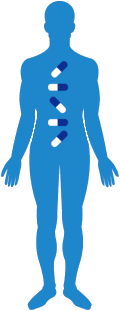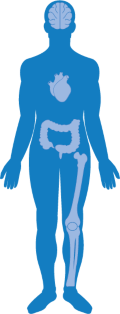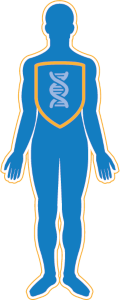Which genes are exactly being tested?
Our pharmacogenetic test checks the following genes: ABCB1, ABCG2, ALDH2, BCHE, COMT, CYP1A2, CYP2B6, CYP2C8, CYP2C9, CYP2C19, CYP2D6, CYP2D6-enhancer, CYP2E1, CYP3A4, CYP3A5, CYP3A7, CYP4F2, DPYD, F2, F5, G6PD, GRIK4, GSTP1, HLA-B*1502, IFNL3, MT-RNR1, MTHFR, NAT2, NUDT15, OPRM1, SLCO1B1, TPMT, UGT1A1 and VKORC1.
A gene that allows for a transport protein. Among other things, it transports medicines from the brain and kidneys, for example.
ABCG2 encodes a transport protein present in the liver, intestines, kidneys, and blood-brain barrier. Its function is to pump out potentially harmful substances, such as medicines, from cells, serving as a defence mechanism.
The ALDH2 gene codes for ALDH2, which stands for Aldehyde Dehydrogenase 2, an important enzyme involved in alcohol metabolism. Aldehyde Dehydrogenase 2 is responsible for the breakdown of a toxic substance, acetaldehyde.
A gene that produces an enzyme that helps protect the body against certain toxic substances by breaking them down before they reach the nerves.
COMT is involved in the conversion of certain "stress" hormones such as dopamine and adrenaline, but also, for example, certain female hormones.
CYP1A2 is part of a large family, the cytochrome P450 enzymes. They are primarily in the liver. This group is involved in the metabolism of approximately 60% of the drugs. 8 to 10% of this is converted by this gene, CYP1A2.
CYP2B6 is part of a large family, the cytochrome P450 enzymes. This group is involved in the metabolism of approximately 60% of the drugs. About 4% of the 200 most commonly prescribed and used medicines, including mainly antiviral drugs, are broken down by CYP2B6.
CYP2C8 is part of a large family, the cytochrome P450 enzymes. This group is involved in the metabolism of about 60% of the drugs. This enzyme accounts for 7% of the total CYP enzyme content in the liver.
CYP2C9 is part of a large family, the cytochrome P450 enzymes. This group is involved in the metabolism of approximately 60% of the drugs. About 10%-20% of all medicines are (partly) converted by CYP2C9.
CYP2C19 is part of a large family, the cytochrome P450 enzymes. This group is involved in the metabolism of approximately 60% of the drugs. Approximately 8% of all medicines are (partly) converted by CYP2C19, including, for example, antidepressants, stomach agents (the proton pump inhibitors) and anticoagulants.
CYP2D6 is part of the cytochrome P450 enzymes, these are enzymes that mainly work in the liver and cause the breakdown of many different substances in the body. This gene is involved in at least 25% of medicines prescribed by doctors, such as antidepressants, antipsychotics, opioids, tamoxifen, antiarrhythmics.
CYP2E1 is part of the cytochrome P450 enzymes, these are enzymes that work primarily in the liver and to a lesser extent in the brain, lungs and kidneys. They cause the breakdown of many different substances in the body.
CYP3A4 is part of the cytochrome P450 enzymes. This enzyme is one of the most important CYP enzymes because it is responsible for processing around 45-60% of the prescribed medicines.
CYP3A5 is part of the cytochrome P450 enzymes, these are enzymes that work primarily in the liver and to a lesser extent in the brain, lungs and kidneys. They cause the breakdown of many different substances in the body.
CYP3A7 is part of a large family, the cytochrome P450 enzymes. They are mainly found in the liver. This group is involved in the metabolism of approximately 60% of the drugs. CYP3A7 is primarily expressed in the fetal liver and is responsible for metabolizing a wide range of substances, including pharmaceutical drugs, steroids, and environmental toxins.
CYP4F2 regulates the bioavailability of vitamin E and vitamin K. Variations in CYP4F2 that affect the bioavailability of vitamin K also affect the dosage of vitamin K antagonists such as warfarin or acenocoumarol.
This gene plays a central role. It is involved in the degradation of the uracil and thymine molecules. These are building blocks of the DNA and the related RNA.
The F2 gene contains instructions for making a protein called prothrombin. This is a clotting factor that is important for blood clotting.
The F5 gene contains instructions for making a protein called coagulation factor V (5). This is a clotting factor that is important for blood clotting.
The G6PD gene provides instructions for making an enzyme called glucose-6-phosphate dehydrogenase. This enzyme plays a vital role in red blood cells. Variations in this gene lead to G6PD deficiency manifested as acute haemolytic anemia.
GRIK4 codes for a protein that transmits signals from the neurotransmitter glutamate in the brain. Not much can be said for certain about this gene yet, but variations in this gene are associated with how your body responds to anti-depressants.
The GSTP1 gene encodes the enzyme glutathione S-transferase Pi 1. It belongs to the glutathione S-transferase (GST) family of enzymes, which are involved in the detoxification and elimination of a wide range of toxic compounds, including carcinogens, drugs, and environmental pollutants. GSTP1 is primarily found in the liver.
HLA-B is an important part of the immune system. It belongs to a family of genes, the HLA complex. It helps the immune system to distinguish between your own proteins and proteins from an intruder, such as a bacterium or a virus.
IFNL3 is a gene that codes for a cytokine. Cytokines are important signal proteins in the immune system. When a threat is detected in your body, many cytokines are activated, which can trigger the immune response.
MT-RNR1 is a gene located in humans’ mitochondrial DNA (mtDNA). It encodes a vital RNA molecule, which is an essential component of the mitochondrial ribosome. Mitochondrial ribosomes are responsible for synthesizing proteins within the mitochondria, the cellular organelles that produce energy. Mutations or alterations in the MT-RNR1 gene can lead to mitochondrial disorders and hearing loss.
The MTHFR gene encodes the enzyme methylenetetrahydrofolate reductase. This enzyme is involved in folic acid metabolism. This folic acid metabolism is essential for the production of DNA and protein synthesis, which in turn are essential for all bodily functions.
The NAT2 gene encodes the enzyme N-acetyltransferase 2. It is primarily expressed in the liver, playing a crucial role in the metabolism of various drugs, chemicals, and environmental compounds.
The NUDT15 gene encodes the enzyme nudix hydrolase 15. Just like TPMT, it is involved in the detoxification of the body. NUDT15 is mainly found in the liver and is also present in other tissues involved in drug metabolism, such as the intestines and bone marrow.
The OPRM1 gene contains instructions for making a protein called the mu (μ) opioid receptor. This is a normal part of our body and is called the opioid system and it is a system where pain, reward but also addiction are regulated.
This SLCO1B1 gene contains the instructions for making a protein called organic anion-transporting polypeptide 1B1 or OATP1B1. It influences the transport of substances in the body. The protein is found in liver cells where it transports compounds from the blood to the liver so that they can be removed from the body.
The TPMT gene encodes the enzyme thiopurine S-methyl transferase. Just like COMT (also a methyl trasferase), TPMT is involved in the detoxification of the body. TPMT is mainly found in the liver and kidneys and is less common in the brain and lungs.
This gene belongs to a family of genes that provide instructions for making enzymes called UDP glucuronosyl transferases. These enzymes carry out a reaction called glucuronidation: this process is a convenient way for the body to make various substances more water-soluble and in this way easier to transport through the body or to remove from the body via urine or bile relief (from the liver).
This gene codes for an enzyme in the liver that plays a key role in the vitamin K cycle. Vitamin K plays an important role in helping to make a blood clot and thus preventing excessive bleeding.




